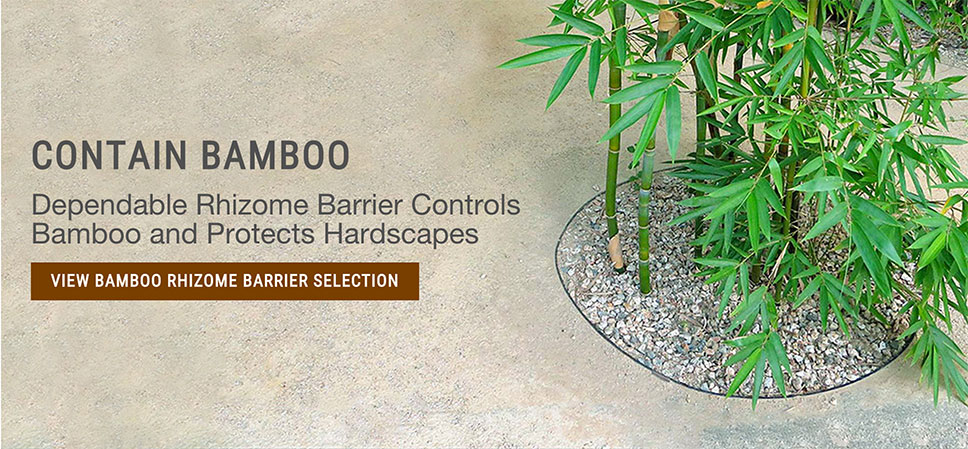Providing a wide selection of dependable tree and bamboo root barrier products.
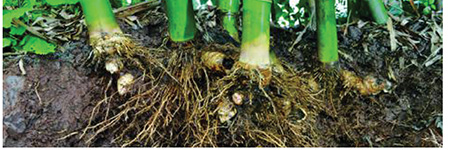
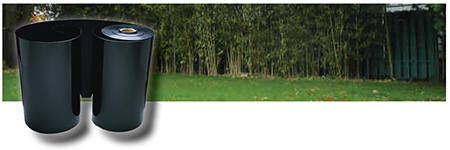
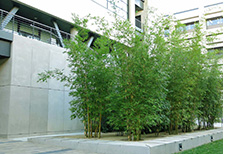
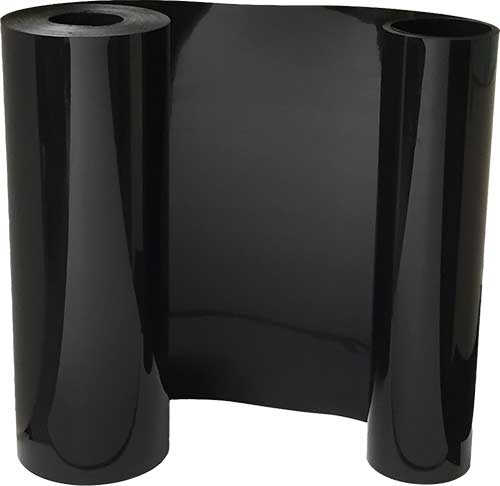
Installation of the barrier is fairly straight forward. First, dig near the bamboo plant to determine how deep the existing roots extend into the ground. Once the depth of the roots is determined it is recommended that a barrier is chosen that is approximately 12” deeper than the depth of the bamboo roots. For example, if the bamboo plant's roots extend 18” into the ground a 30” barrier should be chosen. The reason for going deeper than the existing roots is when the barrier is installed the roots may angle downward attempting to go around the barrier. Although the roots are much more likely to extend upward there is a chance that they could go down. 12” of extra depth on the barrier provides more protection and greatly reduces that chance of the bamboo roots going under the barrier.
Once the appropriate height of barrier has been chosen, dig a trench around the bamboo planting area with a depth that is 2” less than the height of the barrier. For example, if you are installing a 30” barrier, dig a 28” trench. This is to allow 2” of the material to stick above the surface forcing any bamboo rhizomes which are inclined to “jump” the barrier to surface and jump up and over the barrier. The gardener will then have a visual of the jumping rhizome and will have a chance to clip as necessary to prevent spread of the plant.
Cut the material to the appropriate length, place the barrier in the trench and be sure to overlap the material 4 feet at the seam to make a complete circle. Use HDPE seam tape to secure the two pieces together.
Finally backfill the trench around the material. The bamboo planted within the barrier area will now be well contained and if the roots are trimmed properly will not leave the designated area.
If you have any questions regarding our bamboo barrier products, installation or applications feel free to give us a call at (800) 351-9633.
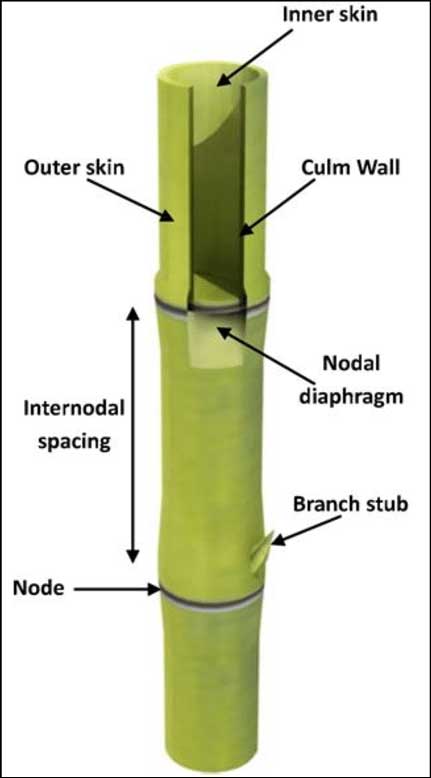
The Pros and Cons of Growing Bamboo Plants
Bamboo is a very interesting plant with over 1,400 species to choose from though many people think there are only 2, runners and clumpers. They are slow runners and open clumpers and have other aspects that affect the growth of bamboo. Running bamboos have long stems that quickly spread horizontally. Runners have a ridge on a hollow stem and are perfectly round. Clumping bamboos have shorter stems that remain closer to their source but do not spread as quickly.
Photo courtesy of Research Gate
The stems are straight and circular in structure, grow above ground, and have nodes that provide strength to the stems. The node on the stem has two rings. The lower ring is called the sheath ring and is formed after the sheath leaf falls off. The upper ring is the stem ring which is formed after the growth of the intranodal tissue is complete.
Bamboo comes in a variety of species and no two are exactly alike. Some stems are hollow and form bamboo cavities while others have a stem with a thick wall.
About Running Bamboo
The majority of ornamental bamboo is considered a runner which sends out roots that search for moisture underground. For those looking for added privacy, this plant will quickly cover fences and other barriers while giving everything a lush look to the landscape. Running bamboo is also easy to find in most standard nurseries because they propagate really well.

One note of caution, when planting this bamboo, keep in mind, that the plant is a running bamboo, nothing else. In the first year, they will sleep, by the second year they will start to creep, and during the third year, they will leap! By then, you will understand why they are called runners!
Running bamboo is invasive and will reap havoc on your neighbor's rose bushes, or their perfectly manicured lawn. If you live in a dry, warm climate like California, it will take no time at all for this plant to search out and find water. They will search through vegetable gardens, herbal gardens, and anything that stands in their way. So much for a peaceful neighborhood!
Read on to discover ways to prevent a neighborhood catastrophe from heading your way:
Give running bamboo plenty of room to spread and grow. If you only have a small amount of room, this plant might not be your best choice. On the other hand, if you have a large vacant area that needs some greenery, running bamboo might be a great choice.
· You can keep running bamboos in containers. There are several ways including a wine barrel or burying a rhizome (stem) barrier into the ground.
· Build a perimeter trench for aggressive varieties of bamboo so they will not become overgrown or overbearing.
· Regularly prune your bamboo including trimming back the shoots and going underground and cutting back the roots.
· Look for smaller, slower varieties of bamboo such as ground cover bamboos. You should still watch out for them. Even though they may seem to be sleeping, they could be in the process of building an underground barrier.
· Consider getting clumping bamboo instead.
There are many beautiful bamboo species that happen to be runners. In most cases, they are less expensive and can be easily found in nurseries.
A few great running bamboo varieties to consider:
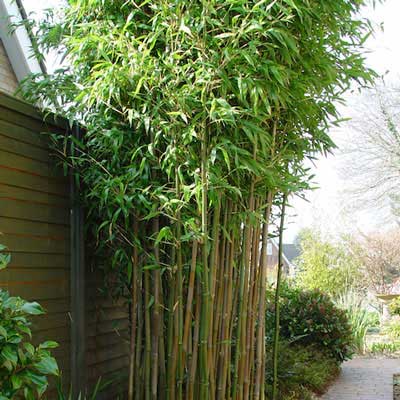
Temple Bamboo (Semiarundinaria fastuosa)
This is an extraordinary variety of bamboo known as Temple Bamboo. This plant can reach 20 to 30 feet in height. Though rich in color, the stems will not grow larger than an inch in diameter. To bamboo enthusiasts, this is an extremely beautiful bamboo with its long, straight, elegant canes.
Arrow Bamboo (Pseudosasa japonica)
Photo courtesy of gardenofeden.blogspot.com
This is another very popular bamboo that got its name from the long, straight poles which Samurai warriors used to make their arrows. Today, Arrow Bamboo is a perfect choice for planting in shady areas of your garden. Even though it is classified as a runner, it's a great deal more restrained in growth than other bamboos in that class.
This is a vibrant plant due to its wide green leaves. Arrow bamboo is a perfect choice for privacy screens due to its growth that is dense and thick. Its height is approximately 12 to 16 feet, making it a great deal more manageable than other bamboo specimens. This is a great choice for privacy hedges with height restrictions.
This plant does require a lot of watering so if you live in a dry climate, like southern California, this might not be your best choice. You should keep this plant in a shady area where it will receive a lot of water runoff.
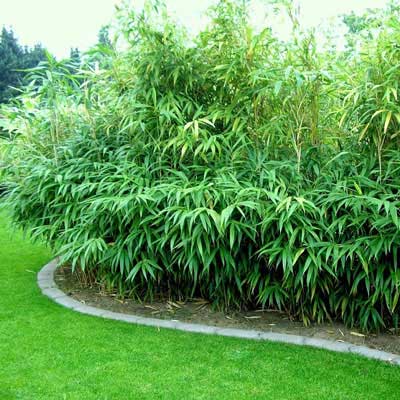

Chinese Timber (Phyllostachys vivax)
You will definitely need extra room for this enormous timber bamboo that can easily reach 20 to 50 feet in height with stems up to 4 to 5 feet in diameter. This plant will have a massive footprint but if you have adequate space, this is a magnificent plant that will be a prized specimen for all bamboo enthusiasts.
It's a good idea to keep running bamboo in a container or pot but it might not be the best solution. Should you place the pot or container on dirt, the roots will find a way to crawl through the drain hole and get into the ground. You'd be better off placing the pots on a patio or a large stepping stone in your garden.
You can plant the Chinese Timber in the ground if you surround it with a strong root barrier. You should give it a wide berth with room to spread at least 8 to 10 feet in diameter. Make sure you bury a deep root barrier and regularly keep an eye on it. If left unattended, this Chinese Timber bamboo will tear through most man-made boundaries.
Black Bamboo (Phyllostachys nigra)
Photo courtesy of gardenbargains.com
With its very dark brown canes that are almost black, this is a very popular and quite beautiful bamboo and you should be able to find it in most nurseries. As the plant matures, the dark color of the stems will become even richer, giving it an impressive contrast against its magnificent bright green leaves.
Due to its beauty, gardeners all around the world are growing this plant. Black Bamboo is native to the Hunan Province of southern China and even though it thrives best in its own subtropical habitat, it can grow very well in USDA zones 7 through 10. If it's planted in rich, loamy soil, it can reach 20 to 30 feet in height and the matured stems will reach 2 inches in diameter.
A healthy specimen will work perfectly as a centerpiece in any garden showing off its beautiful dark canes and flowing foliage. Once the plant is harvested and dried, black bamboo is an excellent plant to work with. Its richly colored poles are used in a number of decorative ways from furniture to fencing.
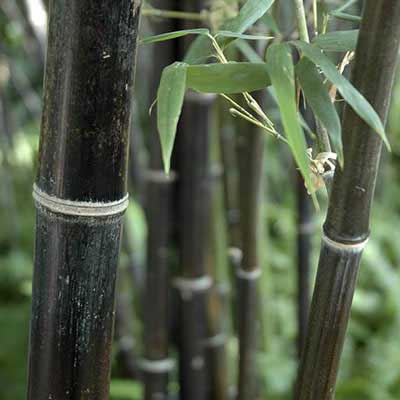
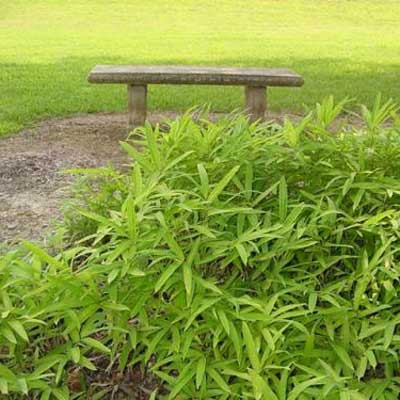
Dwarf Green Stripe
Photo courtesy of midatlanticbamboo.com
This is one of the very few bamboo plants that can be cultivated as a ground cover. It makes an excellent accent next to larger bamboo plants. Place it around Japanese pines, and other kinds of Asian-themed garden settings. Due to its compact size, it's much easier to contain despite being a runner. Like all runners, just keep watch on its roots.
Unlike other striped bamboos, this plant has stripes on its leaves, not on its canes. The stripes are bright yellow with deep green variations. The more sunlight it receives, the lighter the yellow will be and in some cases will turn almost white. Its light green stems are no thicker than a pencil and will rarely grow larger than 2 to 3 feet in height.
Dwarf Green Stripe is somewhat cold-hardy but does not look as vibrant during the winter months. Some gardeners will mow it back during the winter but when spring comes around, it will be even thicker and more colorful than the year before.
About Clumping Bamboo
Gardeners are always in search of really good specimens of clumping bamboo to add to their collection. In general, clumpers are more expensive than runners and more difficult to come across. If you visit your local nursery, there's a chance the clerks might not have clumps or even know what they are.
Blue Bamboo (Himalayacalamus hookerianus)
This gorgeous plant offers powdery blue stems which give it the name Blue Bamboo. This plant comes from the mountains and foothills of southern China and prefers cooler climates, unlike most clumpers. It grows beautifully around ponds and works very well in containers. This particular variety of bamboo does not do well in hot, humid areas.
“Oldham’s” or Giant Timber (Bambusa oldhami)
Photo courtesy of bambooland.com/au
Giant Timber is probably the most popular and grown in the United States. This bamboo is native to Taiwan and prefers warm tropical climates so it's not a good choice for those who live in colder climates. Under perfect conditions, this plant can reach 60 feet in height and 4 inches in diameter. This could be how it got its name “giant”. Giant timber is a splendid variety in the clumper family.
Oldham, or giant timber, is a very popular choice for creating privacy with its bushy leaves and dense canes. Its thick poles make it a great choice for building material. In some cases, bamboo enthusiasts enjoy eating the young, sweet shoots. This plant is so flexible, it's no wonder people grow so many of them.
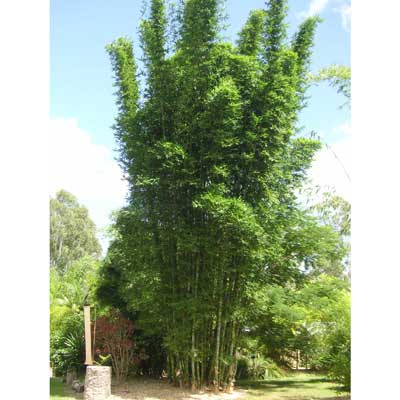
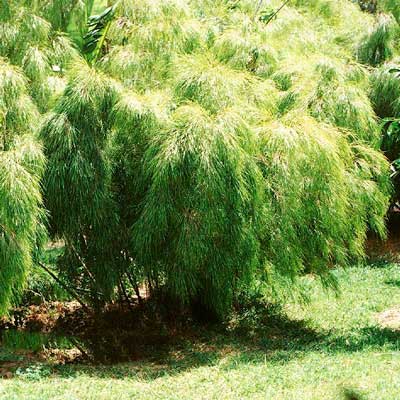
Mexican Weeping Bamboo (Otatea acuminata)
Photo courtesy of bamboonursery.com
This variety has slender stalks, and wispy leaves and will work beautifully in just about any garden. Mexican Weeping Bamboo prefers warmer climates but can grow in cooler coastal climates. Due to its compact size, this plant works well in pots and is cold-hardy down to 20º F. Weeping bamboo is native to northern Mexico. Its slender poles range from 10 to 15 feet in height and its delicate cascading leaves make this a very popular plant.
Buddha's Belly
Photo courtesy of trailorfarms.com
This variety of bamboo got its name from the bulbous shape of its inner nodes. Buddha's Belly is very easy to recognize and one of the larger ornamental clumping bamboos around. Some of its poles grow in a zigzag pattern instead of upright. Its portly appearance makes this plant a popular choice with gardeners and does prefer warmer climates.
The most common variety is the bambusa ventricosa which can reach 30 feet in height with 2 – 3 inch stems. Its enormous Buddha Belly will grow up to 45 feet and the entire clump will spread to 15 feet in width.
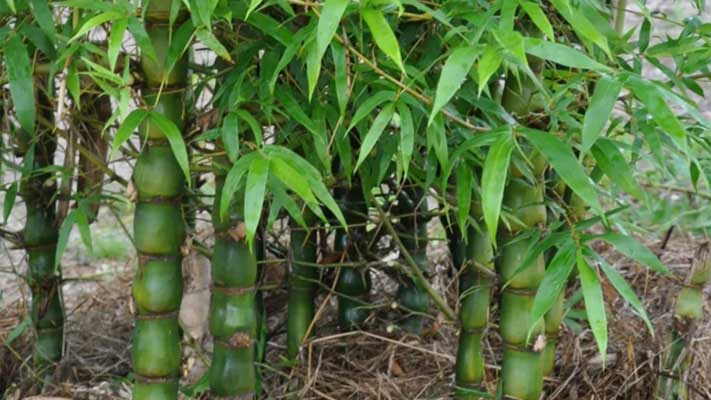
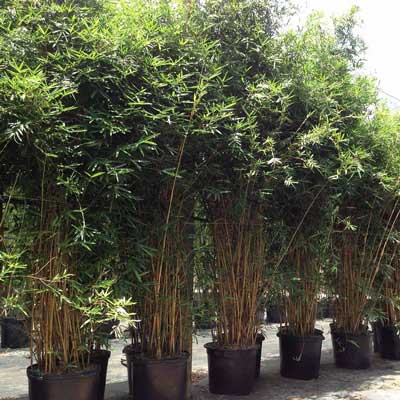
Bambusa Multiplex (Alphonse Karr)
This is one of the most exquisite bamboo plants anywhere with its green and yellow stripes. The Alphonse Karr is perfect as a privacy screen.
Even when this plant is among many other bamboo plants, it will stand out from the crowd. Under perfect conditions, it will reach 20 feet and the stems will grow approximately 1 inch in diameter.
Alphonse is a very slow-growing plant that is commonly used for hedging thanks to its lovely poles. To emphasize its lovely strips, you should prune back all the leaves from the bottom 3 feet.
This bamboo variety is native to the tropics and subtropics of Asia. Alphonse is happiest in warm climates so stay away from USDA zones below 7 or 8.
Understanding Bamboo
If you want to grow these aggressively spreading bamboo plants for a privacy hedge or maybe one of the enormous timber bamboos, but you live in a neighborhood, not out in rural areas, then having a continually growing horizontal underground stem barrier is absolutely fundamental.
Before jumping in, there are a few things you need to keep in mind. First and foremost never underestimate the determination of a healthy bamboo plant. Bamboo is truly a force of nature, unlike other plants. Gardeners are always talking about runners vs clumpers so it's really important you fully understand the difference.
No matter what variety, all bamboos have one thing in common, they want to spread out. You can choose to place these plants in a bucket or a pot but never overlook the fact that if there is a crack or a plug hole in the bucket or pot, the roots of the bamboo will find a way out.
Bamboos Are Super Spreaders
Realize that their underground stems have an incredible ability to search out water, especially in dry climates like Arizona or California. Keep in mind, if your neighbor has drip irrigation in their garden or they continually run their sprinklers to keep their lawn green, it's more than likely your bamboo will send out runners to locate the water source.
Keep in mind, that you cannot simply yank sprouts out of the ground like weeds. It's a known fact that people will spend several hours using a backhoe or a bulldozer to clear out established bamboo. You could spend many hours with a spade or a pickax to keep running underground stems in line. Plan ahead of time to install a bamboo barrier around the planting area otherwise you will most likely be forced to carry out serious maintenance at least once if not twice a year if you want to keep your bamboo under control.
A Quick Rundown
Bamboo Runners – spread in various directions by sending out underground runners or rhizomes which can travel a significant distance from the parent plant. Runners fill in the gaps between plants faster and are ideal for screens, hedges, and open groves.
Bamboo Clumpers – are very short root structures that generally are not capable of expanding more than a few inches each year. They slowly form circular clumps which will enlarge when a new stem (culm) merges each year. They can possibly expand as much as 3 to 10 feet.
Culm – this is a hollow stem of a grass or plant.
Rhizomes – a continually growing horizontal underground stem that sends out shoots and roots at different times.
Intranodal – means within a node.
In Conclusion
Before you jump in too soon, you have to decide which variety of bamboo to plant in your garden. You must consider how much space you have available for the plants and what you want the plants for.
Do you want something that will spread quickly and provide much-needed privacy? Do you want something decorative and compact to accentuate your garden? Possibly, you are growing bamboo for the canes for a project you are planning for in the future
Depending on what you want them for, you can choose either a runner or a clumper and place them in the appropriate place in your garden. I'd read up on the bamboo you want for planting purposes, watering, amount of light, etc. Decide if you want compact bamboo or really tall varieties. Possibly, you want to increase your privacy with something that will spread quickly. If you have several reasons, you should plant different varieties of bamboo and create something spectacular in your garden or establish a new garden in a different area of your yard. You can create something very pleasing that will compliment your overall environment with an array of bamboo.
If you are planning on a totally different garden for the bamboo, decide where the garden will be located then choose the plants that will work best for the level of sun and/or shade.
Remember to install a bamboo barrier which will help to protect your landscape from the overgrowth and spread of bamboo rhizomes.
Once you have selected the bamboo you want, be a little creative in planning out the garden including the decorations such as items made out of bamboo for a really nice balanced touch.
Once all is said and done, just sit back and enjoy your new view or a wonderful privacy wall to keep prying eyes out. Relax while listening to a gentle breeze flowing through the bamboo plants, rustling the leaves or gently knocking the canes together.


